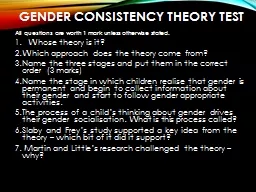PPT-Gender consistency theory test
Author : tatyana-admore | Published Date : 2017-05-16
All questions are worth 1 mark unless otherwise stated Whose theory is it Which approach does the theory come from Name the three stages and put them in
Presentation Embed Code
Download Presentation
Download Presentation The PPT/PDF document "Gender consistency theory test" is the property of its rightful owner. Permission is granted to download and print the materials on this website for personal, non-commercial use only, and to display it on your personal computer provided you do not modify the materials and that you retain all copyright notices contained in the materials. By downloading content from our website, you accept the terms of this agreement.
Gender consistency theory test: Transcript
Download Rules Of Document
"Gender consistency theory test"The content belongs to its owner. You may download and print it for personal use, without modification, and keep all copyright notices. By downloading, you agree to these terms.
Related Documents














